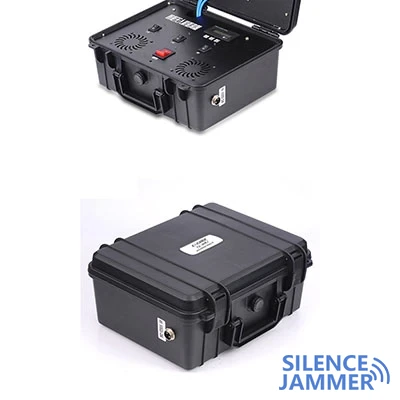A signal jammer is a device that emits electromagnetic waves to interfere with and block the communication of a target device. Its applications range from communication shielding in the military field to anti-cheating equipment in examination rooms. However, different wireless devices operate on different frequency bands, so effective signal jamming requires the ability to adjust the target frequency. This article will introduce in detail how to adjust the target frequency on the signal jammer, including its principles, steps and technical details, and discuss its importance in practical applications.

How signal jammers work
Signal jammers cover normal communication signals and cause interference by emitting electromagnetic waves that are the same as or similar to the operating frequency band of the target device. The effectiveness of a jammer relies on its ability to accurately cover the target frequency band and provide sufficient power to suppress the target signal. Therefore, adjusting the target frequency of the jammer is key to its normal operation.
Basic steps for adjusting target frequency
1. Determine the operating frequency band of the target device
Before adjusting the target frequency of the jammer, you first need to understand the operating frequency band of the interfered device. For example:
Cell phone signals: Typically operate in the 900 MHz, 1800 MHz, 1900 MHz or 2100 MHz frequency bands.
Wi-Fi: Works in 2.4 GHz and 5 GHz frequency bands.
Bluetooth: Works in the 2.4 GHz band.
2. Set the frequency range of the jammer
Jammers often have an adjustable frequency range, allowing the user to adjust the target frequency according to their needs. This process can be carried out through the following steps:
Use frequency synthesizer
A key component in a jammer is the frequency synthesizer, which can generate signals at multiple frequencies and adjust them as needed.
step:
Access the jammer settings interface: Most modern jammers have a user interface, usually operated via physical buttons or control software connected to a computer.
Select frequency synthesizer options: Find the frequency synthesizer setting options in the settings interface.
Enter the target frequency: Enter the required interference frequency according to the working frequency band of the target device. For example, to interfere with Wi-Fi signals, you can set the frequency synthesizer to operate in the 2.4 GHz or 5 GHz band.
3. Adjust transmit power
The transmission power determines the strength of the interference signal and directly affects the effect of interference. Properly adjusting the transmit power can ensure the best interference effect without interfering with other devices.
step:
Find the power setting option: In the jammer's user interface or control software, find the transmit power setting option.
Adjust power output: Increase or decrease transmit power as needed. For example, if Wi-Fi signals are interfered with in an indoor environment, the power can be appropriately reduced to reduce the impact on adjacent areas.
4. Verify using spectrum analyzer
A spectrum analyzer is a device used to measure the electromagnetic spectrum and can help verify that a jammer is properly covering the target frequency band.
step:
Connect the spectrum analyzer: Connect the spectrum analyzer near the jammer or target device.
Scan the spectrum: Scan the target frequency band and observe the strength and coverage of the interfering signal.
Adjust settings: Based on the spectrum analysis results, further adjust the frequency and power settings to ensure the effectiveness of the interference signal.
Practical Application Considerations
1. Legal and Compliance
The use of signal jammers is strictly regulated in many countries and regions. Unauthorized use may violate laws and have serious consequences. Therefore, compliance with the jammer must be ensured before adjusting and using it.
2. Environmental factors
The propagation of wireless signals is affected by environmental factors, such as building structure, materials, and interference from other electronic devices. In practical applications, these factors need to be considered and adjusted according to the specific environment.
3. Multi-band interference
Some modern devices operate on multiple frequency bands. For example, dual-band Wi-Fi routers operate in both the 2.4 GHz and 5 GHz bands. In this case, the jammer needs to be tuned to cover multiple frequency bands simultaneously.
Application of advanced technology
1. Adaptive interference technology
Adaptive interference technology can automatically detect the operating frequency band of the target device and dynamically adjust the interference frequency and power. This technology has significant advantages in complex environments and can improve the accuracy and efficiency of interference.
2. Software Defined Radio (SDR)
Software-defined radio is a technology that uses software to define and adjust radio communication parameters. Through SDR, more flexible and precise frequency adjustment and signal generation can be achieved.
in conclusion
Adjusting the target frequency on the signal jammer is a critical step to ensure its effectiveness. Precise frequency adjustment can be achieved by determining the operating frequency band of the target device, setting the frequency range of the jammer, adjusting the transmit power and verifying it using a spectrum analyzer. Additionally, in practical applications, legal and regulatory compliance, environmental factors, and multi-band interference requirements need to be considered. With the advancement of technology, advanced technologies such as adaptive jamming technology and software-defined radio will further enhance the performance and application range of jammers. Understanding and mastering these adjustment methods will not only help improve the effectiveness of the jammer, but also ensure its legal and compliant use.


